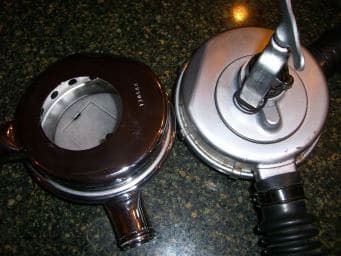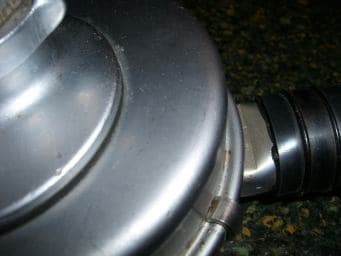world gathers for metal finishing
Q&As since 1989
-----
What's a Butler Finish
Q. I just received a print that calls out for butler finish on stainless steel rolled part. If anybody could help, thanks.
Dan Klayumperformance metal fabricator - Itasca, Illinois, USA
2004
A. A butler finish is a finish produced by fairly fine abrasive, resulting in many parallel lines. Also known as a satin finish or a brushed finish. Some people use butler to mean a finer abrasive than a satin finish, but there is no standard. It's in the eye of the beholder, so it would be good to have a sample to match.

Jeffrey Holmes, CEF
Spartanburg, South Carolina
2004
A. A butler finish is not just a satin finish. To get a true butler finish, you first polish and buff part to a bright finish, then wire brush with very fine stainless or brass wire wheel, turning about 600 to 900 RPM and keep the part wet with water. Some used to use light oil; this produces a satin-like finish but has a lot more depth and finer brush marks then a satin finish. this was also called a "hotel finish" when used on silver serving pieces having high use.
dan parkerretired - port orchard Washington usa
December 8, 2017
What is this 60 year old scuba regulator finish
Q. Hi my name is Dave and I work in a plating shop here in the Bay Area. I have a good customer that brings me old scuba parts to be chrome plated and we do so. Most of the parts he brings us are vintage pieces that are 40+ years old and we strip the corroded finish off, repair and replate. It's mostly dec chrome so no problem. Well he threw me a curve ball the other day. He brought in some parts that were 60+ years old with a different finish on them.
Here are the two finishes side by side: 
Here is a close up of the finish:
At first I thought it was a butler chrome but it doesn't match up. I then thought it was a sulfamate nickel. But I'm not sure how long ago companies were doing that en mass. I will say that this finish has held up extremely well as compared to the dec chrome. It also "feels" more substantial and thicker than decorative chrome.
Does anybody know what this could be? Keep in mind that these were plated 60 years ago. Any help is appreciated.
Dave AliShop Employee - San Francisco, California, USA
May 7, 2008
|
A. Dave, It is very difficult to tell what a metal is just from a photograph. However, it does look like dull or satin nickel. I think you are correct in thinking it is not sulphamate nickel because, f I remember correctly, nickel sulphamate didn't become widely commercially available until the mid 1960's or later. This suggests it could be a Watts nickel, but that won't make any difference to what metal it is! You can do a nickel-specific test by putting a drop of dimethyl glyoxime on the nickel - it will turn blood red in the presence of nickel and virtually no other metal. It is also a very sensitive test, so even trace levels or nickel will give a positive reaction.  Trevor Crichton R&D practical scientist Chesham, Bucks, UK May 9, 2008 A. These parts are made of what, brass? If you can find someone with a test instrument like an X-Ray Florescence unit, you should be able to determine the composition. My own guess is that it is an unbrightened nickel, although not necessarily sulphamate. Before the age of self-leveling nickel, people would nickel plate on top of polished materials, perhaps with a Watts nickel bath, and then possibly buff again. If the brass was left unpolished (and it does appear that there are "dents" or "holes" in this unit under the plating), this is probably something like what you would get. So, without benefit of instrumentation, my bet is it's a very heavy unbrightened nickel. Why is it not yellowish? My guess is that it is chrome plated too -- which was doable by 60 years ago. It could even be nickel followed by hard chrome. Now the people who really know what they're talking about may be inspired to answer, starting with "sometimes Ted can be an idiot" :-)  Ted Mooney, P.E. Striving to live Aloha finishing.com - Pine Beach, New Jersey May 9, 2008 |
![]() Yes the base material is brass, sorry I didn't make that clear before. I just tried something out with a piece that the guy gave me to experiment with. Here's what I did:
Yes the base material is brass, sorry I didn't make that clear before. I just tried something out with a piece that the guy gave me to experiment with. Here's what I did:
I put a piece in our chrome stripper and pulled it out in a matter of minutes. Once I pulled it out it had that yellow nickel tint we all know and love BUT the gray was still there. So my conjecture is that
#1 Ted is NOT an idiot! I think this was chromed on top of nickel. But I don't think it was hard chrome, here's why I think that: the strip process was only a couple of minutes, my understanding is that if it was EHC (since we don't do that in our shop) the strip process would take much longer. I know it could've been a very thin layer but that's just the feeling I had.
Also the thickness of the (what I'll call) Nickel layer is MUCH thicker than the later regs that were plated with decorative chrome. I mean orders of magnitude thicker. So another question I had was:
Since we have never plated nickel that thick, would sulfamate nickel be a good substitute? I mean I have to make a new tank anyways since our nickel tanks are set up right now for bright and semi-bright and this is so small scale it's not going to warrant floor space. But some of the "home plater" distributors have small tank kits that may be useable for the few of these oddballs we get in. Do you guys have any faith in those kits? I mean a Watts bath is a Watts bath, right?
Here's conjecture #2: Ted is STILL not an idiot! If I look at one of the unstripped pieces much closer, I can see a bit of "blue" which would come from the chrome top layer.
Thanks again guys ... I just found this site and already it has given me more info than any EHC shop in the area I've talked to to find this out.
Plater - San Francisco, California
A. Nickel spot test: Place two drops of hydrochloric acid on object, after short time remove it with piece of filter paper and add few drops of ammonia(on wet spot formed on filter paper),then add drop of 1-2% dimethyglyoxime solution-if object is nickel plated result must be bloody red colour.Hope it helps and good luck!
Goran Budija- Cerovski vrh Croatia
May 12, 2008
Q, A, or Comment on THIS thread -or- Start a NEW Thread
